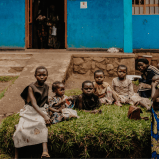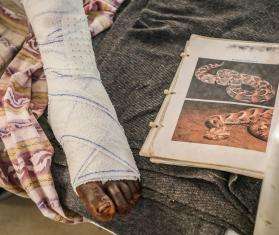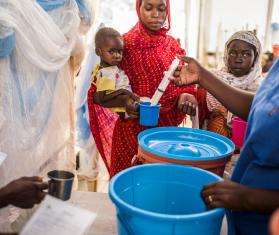Mpox cases have been on the rise in the Democratic Republic of Congo (DRC) for more than two years, and the situation has worsened in recent months. As the virus has mutated, leading to human-to human transmission, there has been a surge in the number of people infected and suspected cases in camps for displaced people.
Here, Dr. Louis Albert Massing, medical coordinator for Doctors Without Borders/Médecins Sans Frontières (MSF) in DRC, breaks down the mpox situation and explains how MSF is responding to this new emergency.
What is mpox and what risks does it pose?
Mpox is a disease caused by the monkeypox virus. It is transmitted by close contact between individuals or with infected animals. It has been endemic in Central Africa and West Africa since the 1970s, and spread rapidly around the world in 2022 and 2023, with tens of thousands of cases linked to the West African variant reported in more than 110 countries.
Mpox symptoms include causes rashes, lesions, and pain, all of which require supportive treatment to avoid further complications. Most patients treated recover within a month, but the disease can be fatal if left untreated. In DRC, where the mortality rate for the strain is much higher than in West Africa, more than 479 people have died since the start of the year. By comparison, the WHO estimates that mpox claimed the lives of 89 people worldwide in 2022.

What is the mpox situation in DRC?
Historically, mpox is endemic in 11 of the country's 26 provinces. However, the number of cases has been rising sharply for more than two years, leading health authorities to declare an epidemic in December 2022. The number of cases tripled in 2023, with more than 14,600 suspected cases reported and 654 deaths. But in 2024, the situation has worsened further. Between January and mid-July, more than 12,300 suspected cases were reported, and 23 provinces were affected.
The acceleration of the epidemic is worrying, especially as a genetic mutation has been identified in South Kivu, with human-to-human transmission going uninterrupted for months. Another cause for concern is that the disease has been recorded in the camps for displaced people around Goma in North Kivu, where the extreme population density is making the situation very critical. There is a real risk of an explosion, given huge population movements in and out of the DRC.
The identification of cases, monitoring of patients, and care available remain extremely limited, while the lack of vaccines makes the situation even more difficult. The perception that the disease is linked to mysticism or witchcraft in some communities also complicates people's adherence to public health measures. This illustrates the need to work closely with community leaders to get everyone to adhere to the measures. MSF is calling for the mobilization of all involved in the response, and for the populations most at risk to be protected as quickly as possible by vaccination.
What is the vaccine situation in DRC?
DRC has validated two vaccines and is trying to obtain supplies, but at this stage, no vaccine is available yet. Negotiations are underway with certain countries and priority areas are being identified. We hope it will soon be sorted out and that sufficient vaccines will be supplied to the country in the main epidemic areas.

How are MSF teams responding to mpox in the meantime?
We have set up several interventions to support the response to this outbreak. Since mid-June, one of our teams has been supporting Uvira health zone in South Kivu. We are supporting the provision of care for people with severe symptoms at the Uvira general referral hospital, following up with patients with milder forms of the disease on an outpatient basis, and isolating suspected cases. Our teams are training medical staff on medical management and are also involved in infection control and raising community awareness. Over the last five weeks, more than 420 patients have already been treated by MSF in Uvira, including 217 serious cases. We are also providing hospitals with kits for treatment and for taking samples.

MSF responds to mpox outbreak in Bolomba, DR Congo
Read moreIn Goma, North Kivu, we have launched surveillance and awareness-raising activities in the IDP [internally displaced people] sites where we are present, and we are strengthening health care structures in terms of triage, isolation, and management of patients presenting mpox symptoms.In the northwest of the country, two other interventions have been launched: one in Bikoro health zone in Equateur, and the other in the Budjala health zone in South-Ubangi. Both interventions will be carried out for several months.
The projects are training medical staff on medical and psychological care and strengthening epidemiological surveillance and infection control and prevention, including raising community awareness, particularly for populations that are sometimes more difficult to involve, such as people with disabilities. In Budjala, 329 patients were treated with our support between mid-June and mid-July. In Equateur province, we will also be conducting operational research with the health authorities to better understand the dynamics of the virus and how to combat the disease.


From left: View of the patient triage area at the Budjala General Referral Hospital; MSF teams prepare beds to accommodate patients with mpox at Uvira General Reference Hospital in South Kivu. DRC 2024 © MSF
What should the immediate priorities be?
The epidemic is spreading in areas with a wide range of demographic and geographical characteristics. The response must be not only multisectoral but also adapted to each context. Pending the arrival of vaccines, partners must support other key aspects of the response including laboratory analysis, surveillance, isolation, awareness-raising, and, of course, patient care. Today, all these aspects suffer from shortcomings and require enormous resources to function properly.
We can only plead, like so many others, for the vaccines to arrive in the country as quickly as possible and in large quantities so we can protect people in the areas most affected—particularly the most at-risk populations such as Congolese health workers, who are on the front line of the infection, as well as other at-risk populations such as sex workers and displaced people in the camps.





